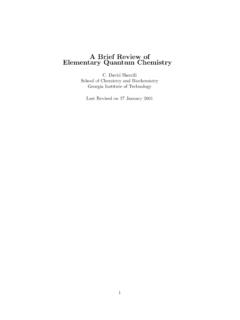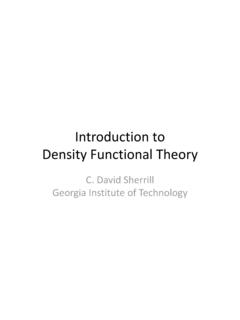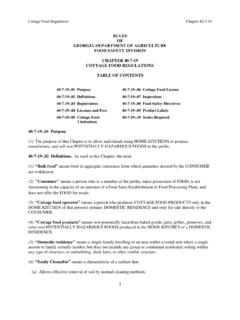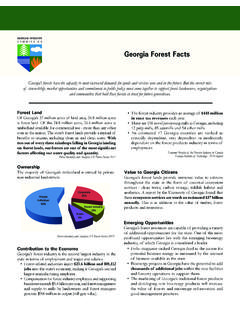Transcription of School of Chemistry and Biochemistry Georgia …
1 Introduction to Molecular MechanicsC. David SherrillSchool of Chemistry and BiochemistryGeorgia institute of TechnologyIntroductionMolecular Mechanicsorforce-field methodsuse classical typemodels to predict the energy of a molecule as a function of itsconformation. This allows predictions of Equilibrium geometries and transition states Relative energies between conformers or between differentmoleculesMolecular mechanics can be used to supply the potential energyfor molecular dynamics computations on large , they are not appropriate (nor are mostab initiomethods!) for bond-breaking InteractionsExpress energy due to stretching bonds as a Taylor series aboutthe equilibrium positionRe:E(R) =k2(R Re)2+k3(R Re)3+ (1)whereRis a bond length. The first term should do we get theparameters(k2andk3, etc.)? Could getfrom experiment or by a full quantum mechanical central idea of molecular mechanics is that these constantsaretransferrableto other C H bond lengthsare to A in just about any molecule, with stretchingfrequencies between 2900 and 3300 cm 1.
2 This strategy isrefined using different atom types. Figure 1: Atom Types for MM2 The Force-FieldMolecular mechanics expresses the total energy as a sum ofTaylor series expansions forstretchesfor every pair of bondedatoms, and adds additional potential energy terms coming frombending,torsional energy,van der Waals energy,electrostatics,andcross terms:E=Estr+Ebend+Etors+Evdw+Eel+Ecross .(2)By separating out the van der Waals and electrostatic terms,molecular mechanics attempts to make the remaining constantsmore transferrable among molecules than they would be in aspectroscopic force D. H. Andrews (Phys. Rev., 1930) proposed extendingspectroscopic force field ideas to doing molecular mechanics F. H. Westheimer (1940) performed the only molecularmechanics calculation done by hand to determine thetransition state of a tetrasubstituted biphenyl J.
3 B. Hendrickson (1961) performs conformational analysisof larger than 6 membered rings K. B. Wiberg (1965) publishes firstgeneralmolecularmechanics type program with ability to find energyminimum N. L. Allinger [Adv. Phys. Org. , 1 (1976)]publishes the first (MM1) in a series of highly popularforce fields; the second, MM2, follows in 1977 Many other force field methods have been developed overthe yearsStretch EnergyThe stretching potential for a bond between atoms A and B isgiven by the Taylor seriesE(RAB) =kAB2(RAB RAB0)2+kAB3(RAB RAB0)3(3)+kAB4(RAB RAB0)4+ and different force field methods retain different numbers ofterms in this expansion (frequently, only the first term is kept).Note that such expansions have incorrect limiting behavioratlarge Potentials for Stretch EnergyA simple function with correct limiting behavior is the MorsepotentialEstr(R R0) =D[1 e k/2D(R R0)]2,(4)whereDis the dissociation energy.
4 However, this potentialgives very small restoring forces for largeRand therefore causesslow convergence in geometry optimization. For this reason,the truncated polynomial expansion is usually 2:Stretching Potential for CH4with exact, 2nd order, 4thorder, and Morse potentials (Jensen, Introduction to ComputationalChemistry)Bend EnergyBending energy potentials are usually treated very similarlyto stretching potentials; the energy is assumed to increasequadratically with displacement of the bond angle ( ABC ABC0) =kABC( ABC ABC0)2(5)An unusual thing happens for ABC= 180o: the derivative ofthe potential needs to go to zero. This is sometimes enforced(Fig. 3).Figure 3: Bending Potential for H2O (Jensen)Out-of-Plane BendingThe potential for moving an atom out of a plane is sometimestreated separately from bending (although it also involvesbending).
5 An out-of-plane coordinate (either ord) isdisplayed below. The potential is usually taken quadratic inthis out-of-plane bend,Ebend oop( B) =kB( B)2.(6)Torsional EnergyThe torsional energy term attempts to capture some of thesteric and electrostatic nonbonded interactions between twoatoms A and D connected through an intermediate bond B torsional angle (also often denoted ) is depicted is the angle betwen the two planes defined by atoms A, B,and C and by B, C, and of the Torsional PotentialThe torsional potential is not expanded as a Taylor seriesbecause the torsional angle can go far from series are used instead:Etors( ABCD) = n=1 VABCD ncos(n ABCD).(7)Often this is rewritten to make sure the energy is non-negative,and typically the number of terms is 3 (bad for octahedral!).Etors( ABCD) =12 VABCD1[1 +cos( ABCD)](8)+12 VABCD2[1 cos(2 ABCD)]+12 VABCD3[1 +cos(3 ABCD)].
6 For a molecule like ethylene, rotation about the C=C bondmust be periodic by 180o, so only even termsn= 2,4, ..canoccur. For a molecule like ethane, only termsn= 3,6,9, ..can 4: Torsional Potentials forn= 3 and 2 (Jensen)Figure 5: Example Torsional Potential forn= 1 (Jensen)van der Waals EnergyThe van der Waals energy arises from the interactions betweenelectron clouds around two nonbonded range:strongly repulsiveIntermediate range:attractiveLong range:goes to zeroThe attraction is due toelectron correlationwhich results in dispersion or London forces (instantaneous multipole/induced multipole).Form of the van der Waals Energyvan der Waals energies are usually computed for atoms whichare connected by no less than two atoms ( , 1-4 interactionsbetween A and D in A-B-C-D and higher). Interactions betwenatoms closer than this are already accounted for by stretchingand/or bending intermediate to long ranges, the attraction is proportionalto 1/R6.
7 At short ranges, the repulsion is close to , an appropriate model of the van der Waals interactionisEvdw(RAB) =Ce DR ER6.(9)Since the van der Waals and electrostatic interactions arelong-range, they can become the dominant costs of force-fieldcomputation. The van der Waals term can be speeded upsubstantially by a more economical expression, the Lennard-Jones potentialEvdw(RAB) = [(R0R)12 2(R0R)6].(10)TheR 12term is easier to compute than the exponentialbecause no square roots need to be taken to getR. Figure 6presents a comparison of various van der Waals 6: Example van der Waals Potentials (Jensen)Electrostatic EnergyElectrostatic terms describe the Coulomb interaction betweenatoms A and B with partial charges ( , in carbonyls),according toEel(RAB) =QAQB RAB,(11)where is an effective dialectric constant which is 1 in vacuumbut higher when there are intermediate atoms or is picked fairly arbitrarily.
8 Higher values or so-called distance-dependent dialectrics ( = 0 RAB) account for screening and kill off the electrostatic contributions faster,making them easier to Approaches to ElectrostaticsA slightly different approach to partial charges is to considerpolarized bonds as dipoles, and compute the electrostaticinteraction between these dipoles ( , MM2 and MM3):Eel(RAB) = A B (RAB)3(cos 3 cos Acos B),(12)where is the angle between the dipoles and Aand Barethe angles each dipole makes with the line joining atoms A Atomic ChargesAtoms don t have charges!! Quantum mechanics tells uselectrons are smeared out, and their charge is shared amongnearby atoms. No unique way to assign electrons to , atomic charges are a useful favored procedure is to perform a quantum computationand then choose charges that reproduce the quantum electro-static potential.
9 Restrained Electrostatic Potential (RESP)procedure used for AMBER force field. esp(r) =nuc AZA|RA r| (r ) (r )|r r|dr (13)Computational Cost of Electrostatic TermsLike van der Waals terms, electrostatic terms are typicallycomputed for nonbonded atoms in a 1,4 relationship or furtherapart. They are also long range interactions and can dominatethe computation number of nonbonded interactions growsquadraticallywith molecule size. The computation time can be reduced bycutting off the interactions after a certain distance. The vander Waals terms die off relatively quickly ( R 6) and canbe cut off around 10 A. The electrostatic terms die off slower( R 1, although sometimes faster in practice), and are muchharder to treat with cutoffs. This is a problem of interest Electrostatic EnergiesThe point-charge model has serious deficiencies: (a) electro-static potentials are not accurately reproduced; (b) simplemodels don t allow the charges to change as the molecular ge-ometry changes, but they should; (c) only pairwise interactionsare considered, but an electrostatic interaction can actuallychange by 10-20% in the presence of a third body (inductionor polarization effects).
10 Improved Electrostatic PotentialsElectrostatic potentials can be more accurately reproduced by: Allowing non-atom-centered charges Adding point dipoles, quadrupoles, are employed in Anthony Stone sDistributed MultipoleAnalysis (DMA). However, this does not yet allow the elec-trostatic variables to change as a function of geometry or torespond to electrostatic potentials generated by nearby requirespolarizable force-fieldssuch as the fluctuatingcharge Fluctuating Charge ModelConsider the energy as a function of the number of electronsN:E=E0+ E N N+12 2E N2( N)2+ (14)Electronetativity = E/ N. Chemical hardness = 2E/ N2. Setting Q= Nand expanding about thepoint with no net atomic charges,E= Q+12 Q2+ (15)Considering the electrostatic energy also depends on theexternal potential , and summing over all sites (usuallyatomic centers),Eel= A AQA+ A AQA+12 ABQAQB.


















